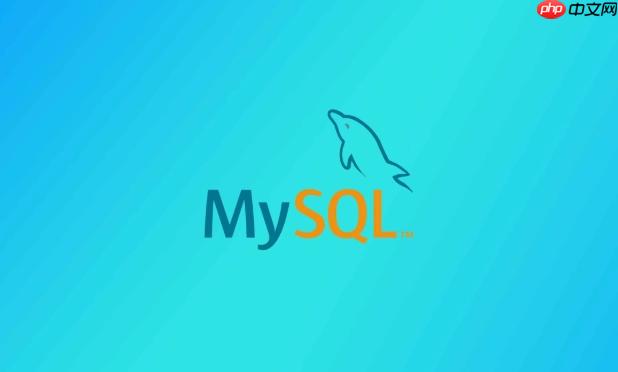答案:linux下配置mysql需先安装服务,再进行安全初始化、配置文件修改、防火墙设置及用户权限管理。具体包括使用apt或yum安装MySQL,运行mysql_secure_installation设置安全选项,修改my.cnf配置文件以调整字符集、绑定地址和性能参数,开放3306端口防火墙规则,创建专用用户并授权;若启动失败,需检查日志、端口占用、配置语法、磁盘空间和权限;重置root密码可通过–skip-grant-tables(MySQL 5.7及以下)或init-file方式(MySQL 8.0+);性能优化涉及索引设计、SQL分析、缓冲池调优、硬件升级与定期维护。

Linux下配置MySQL,简单来说就是安装MySQL服务,然后进行一些基本的安全设置和性能优化。安装方式有很多,取决于你的Linux发行版,配置则是为了让MySQL更好地服务你的应用。
解决方案
-
安装MySQL服务:
sudo apt update sudo apt install mysql-server
安装过程中可能会提示设置root密码,请牢记。如果忘记,后续可以重置。
- centos/RHEL: 使用
yum
或
包管理器。
sudo yum install mysql-server # 或者 sudo dnf install mysql-server sudo systemctl start mysqld sudo systemctl enable mysqld # 设置开机自启
CentOS 7/RHEL 7 默认是mariadb,想安装MySQL需要先添加MySQL官方的YUM源。CentOS 8/RHEL 8 默认使用
dnf
。
- 通用二进制包: 从MySQL官网下载对应Linux版本的二进制包,解压后配置环境变量,然后手动启动。这种方式比较灵活,但也更复杂,适合对MySQL有深入理解的用户。
- centos/RHEL: 使用
-
初始化MySQL(重要):
安装完成后,需要运行MySQL的安全初始化脚本。
sudo mysql_secure_installation
这个脚本会引导你设置root密码,删除匿名用户,禁止远程root登录,以及删除测试数据库。强烈建议按照提示操作。
-
登录MySQL:
mysql -u root -p
输入你在
mysql_secure_installation
中设置的root密码。如果忘记密码,需要重置。
-
配置MySQL:
MySQL的配置文件通常位于
/etc/mysql/mysql.conf.d/mysqld.cnf
(Debian/Ubuntu) 或
/etc/my.cnf
(CentOS/RHEL)。
- 字符集: 修改默认字符集,支持中文等。
[mysqld] character-set-server=utf8mb4 collation-server=utf8mb4_unicode_ci [client] default-character-set=utf8mb4
- 绑定地址: 默认只允许本地连接,如果需要远程连接,需要修改
bind-address
。
#bind-address = 127.0.0.1 # 注释掉这一行或者修改为 0.0.0.0 允许所有IP连接
警告: 允许所有IP连接存在安全风险,请谨慎操作,并配合防火墙规则。
- 性能优化: 根据服务器配置调整
innodb_buffer_pool_size
等参数,提高MySQL性能。
修改配置文件后,需要重启MySQL服务:
sudo systemctl restart mysql
-
防火墙设置:
如果开启了防火墙,需要允许MySQL的3306端口通过。
- UFW (Ubuntu):
sudo ufw allow 3306
- Firewalld (CentOS/RHEL):
sudo firewall-cmd --permanent --add-port=3306/tcp sudo firewall-cmd --reload
-
创建用户和授权:
不要使用root用户进行日常操作,创建新的用户并授予相应的权限。
CREATE USER 'your_user'@'localhost' IDENTIFIED BY 'your_password'; GRANT ALL PRIVILEGES ON your_database.* TO 'your_user'@'localhost'; FLUSH PRIVILEGES;
如果需要允许远程连接:
CREATE USER 'your_user'@'%' IDENTIFIED BY 'your_password'; GRANT ALL PRIVILEGES ON your_database.* TO 'your_user'@'%'; FLUSH PRIVILEGES;
警告: 授予
ALL PRIVILEGES
权限要谨慎,根据实际需要授予最小权限。
如何解决MySQL启动失败的问题?
MySQL启动失败的原因有很多,最常见的是端口被占用、配置文件错误、磁盘空间不足等。
-
查看日志: MySQL的错误日志通常位于
(Debian/Ubuntu) 或
/var/log/mysqld.log
(CentOS/RHEL)。仔细查看日志,可以找到具体的错误信息。
-
端口占用: 使用
netstat -tulnp
或
ss -tulnp
命令查看3306端口是否被其他程序占用。如果是,停止占用端口的程序或者修改MySQL的端口。
-
配置文件错误: 检查
/etc/mysql/mysql.conf.d/mysqld.cnf
或
/etc/my.cnf
配置文件是否存在语法错误。可以使用
mysqld --validate-config
命令验证配置文件的正确性。
-
磁盘空间不足: 检查磁盘空间是否足够,特别是
/var/lib/mysql
目录所在的磁盘。
-
权限问题: 确保MySQL用户对数据目录有读写权限。
如何重置MySQL root密码?
忘记MySQL root密码是很常见的问题。重置密码的方法略有不同,取决于MySQL的版本。
-
MySQL 5.7及之前:
- 停止MySQL服务。
sudo systemctl stop mysql
- 以跳过权限验证的方式启动MySQL。
sudo mysqld_safe --skip-grant-tables &
- 登录MySQL。
mysql -u root
- 修改root密码。
UPDATE mysql.user SET authentication_string=PASSWORD('your_new_password') WHERE User='root'; FLUSH PRIVILEGES; exit;- 停止MySQL服务,并以正常方式启动。
sudo systemctl stop mysql sudo systemctl start mysql
-
MySQL 8.0及之后:
- 停止MySQL服务。
sudo systemctl stop mysql
- 创建包含重置密码命令的文件,例如
reset_password.sql
。
ALTER USER 'root'@'localhost' IDENTIFIED BY 'your_new_password';
- 以安全模式启动MySQL。
sudo mysqld --init-file=/path/to/reset_password.sql --user=mysql --console
- 启动完成后,登录MySQL。
mysql -u root -p
输入你在
reset_password.sql
中设置的新密码。
如何优化MySQL性能?
MySQL性能优化是一个很大的话题,涉及到很多方面。
-
索引: 合理使用索引可以大大提高查询速度。但索引也不是越多越好,过多的索引会降低写入性能。
-
查询优化: 使用
EXPLaiN
命令分析SQL查询语句,找出性能瓶颈。避免全表扫描,尽量使用索引。
-
配置优化: 根据服务器配置调整
innodb_buffer_pool_size
、
key_buffer_size
、
query_cache_size
等参数。
-
硬件升级: 如果软件优化效果不明显,可以考虑升级硬件,例如增加内存、使用SSD等。
-
定期维护: 定期进行表优化(
OPTIMIZE TABLE
)和碎片整理,可以提高查询效率。
-
监控: 使用MySQL自带的监控工具或者第三方监控工具,实时监控MySQL的性能指标,及时发现问题。例如使用
SHOW GLOBAL STATUS
查看各种状态变量。
-
分库分表: 当单表数据量过大时,可以考虑分库分表,将数据分散到多个数据库或表中。
优化是一个持续的过程,需要不断地监控和调整。不要盲目地修改配置,要根据实际情况进行分析和调整。


评论(已关闭)
评论已关闭